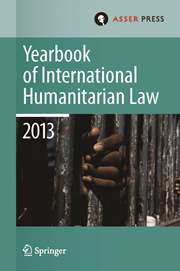No CrossRef data available.
Article contents
Some Comments on the Elements of Crimes for the Crimes of the ICC Statute1
Published online by Cambridge University Press: 17 February 2009
Extract
On 30 June 2000, the Preparatory Commission for the International Criminal Court (ICC) adopted by consensus the draft Elements of Crimes for the crimes of genocide, crimes against humanity and war crimes, as defined in Articles 6, 7 and 8 of the Rome Statute of the International Criminal Court (the Statute). Herewith, the Preparatory Commission fulfilled its mandate to elaborate such elements in accordance with the time-limit set out in resolution F of the Final Act, adopted by the Rome Conference on 17 July 1988.
- Type
- Current Developments
- Information
- Copyright
- Copyright © T.M.C. Asser Instituut and the Authors 2000
References
4. The full text of the draft Elements of Crimes is found in the Report of the Preparatory Commission for the International Criminal Court, Addendum, Finalized draft text of the Elements of Crimes, PCNICC/2000/INF/3/Add.2, 6 July 2000.
5. Report of the Preparatory Committee on the Establishment of an International Criminal Court, Volume I (Proceedings of the Preparatory Committee during March-April and August 1996), United Nations General Assembly Official Records, Fifty-first Session, Supplement No. 22, A/51/22 (1996) [hereinafter, 1996 Preparatory Committee Report, Vol. I], para. 56.
6. For such an overview, see, Lee, R.S., et al. , eds., The International Criminal Court, The Elaboration of the Elements of Crimes and the Rules of Procedure and Evidence, forthcoming (Irvington-on-Hudson, NY, Transnational Publishers 2001)Google Scholar.
7. The Court shall in the future also exercise jurisdiction over the crime of aggression, once agreement can be reached on the definition of this crime. See Art. 5(2) ICC Statute.
8. For more details on this issue, see infra, Part 5.
9. See the elements for Art. 7(l)(g)-l to 6 (crimes against humanity) and Art. 8(2)(b)(xxii)-l to 6 (war crimes in international armed conflicts) and Art. 8(2)(e)(vi)-l to 6 (war crimes in non-international armed conflicts).
10. The technical problems related to the fact that the elements should clearly spell out that this crime is normally committed by more than one person, who are responsible for different parts of the crime of disappearance. The political problems related to the fact that a number of Latin American countries wanted to ensure that present governments would not, after the entry into force of the Statute, be confronted with charges relating to disappearances of persons for which former governments should be held responsible.
11. See on these issues, infra, Part 4.
12. The conjunctive formulation of ‘intent’ and ‘knowledge’ was not intended to change the existing theory and practice in this respect. See Piragoff, D.K. in Triffeter, O., ed., Commentary on the Rome Statute of the International Criminal Court, Observers Notes, Article by Article (Baden-Baden, Nomos Verlagsgesellschaft 1999) pp. 530–531Google Scholar.
13. It is, in this context, important to mention that the Preparatory Commission did not always analyse the various concepts used or elaborate on the dividing line between the different kinds of material elements and between the material and mental elements. Views on these issues varied between the different legal systems and it may very well be that delegations did not have a common approach in this respect.
14. See infra, Part 5.
15. The terms ‘know’ and ‘was aware of’ are, under this article, interchangeable.
16. It has been discussed whether Art. 30 would also encompass other mens rea requirements than intent and knowledge. Some delegations, for example, argued that recklessness, as a form of intent, may fall under the scope of the article. It is, however, left to the Court to further analyse and determine the mens rea requirement that follows from Article 30.
17. See infra, part 5.
18. For a proper understanding of the contextual element, it is also necessary to take into account two other elements that can be found in each set of elements for each genocidal act, and which read:
— Such person or persons [i.e., the persons against whom the genocidal conduct is aimed] belonged to a particular national, ethnical, racial or religious group.
— The perpetrator intended to destroy, in whole or in part, that national, ethnical, racial or religious group, as such.
19. These delegations also invoked the judgement of the Trial Chamber of the ICTY in the Kupreškić case, according to which the concept of crimes against humanity does not necessarily imply a policy element, and according to which crimes against humanity can also be committed by persons not acting on governmental authority but with some sort of explicit or implicit approval or endorsement by a state authority. Prosecutor v. Zoran Kupreškić el al, Case No. IT-95–16-T, Judgement of the Trial Chamber of 14 January 2000, paras. 551 and 555.
20. The case law of the ICTY concerning a determination of the character of the armed conflict in different parts of the former Yugoslavia underlines the complexities behind both the legal requirements for this distinction as well as behind the assessment of the facts in relation to those legal requirements.


